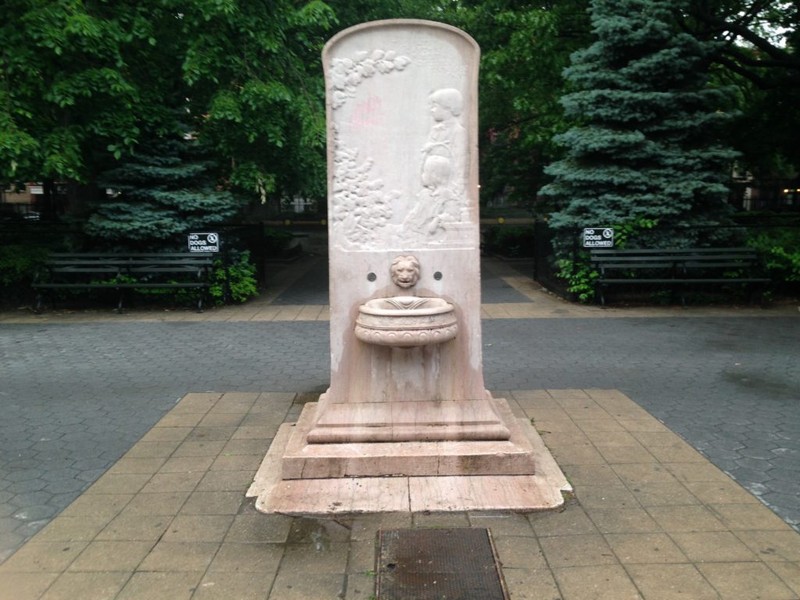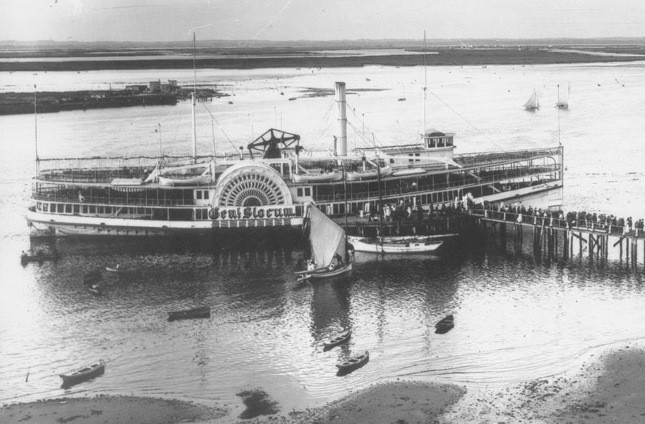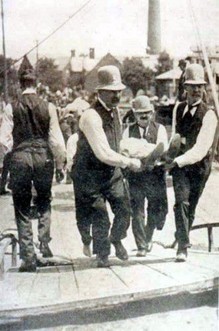Slocum Memorial Fountain
Introduction
Text-to-speech Audio
Images
Slocum Memorial Fountain in Tompkins Square Park

PS General Slocum

Debris from the ship and bodies of the victims washed up on the shores of the East River in the aftermath of the tragedy
.jpg)
Rescuers at the scene carrying one of the victims on a stretcher

Backstory and Context
Text-to-speech Audio
On the morning of June 15, 1904, the General Slocum left the pier at the end of East Third Street and began traveling up the East River, destined for Locust Grove, a picnic site on the north shore of Long Island. The wooden triple-deck, side-wheel steamer, built in Brooklyn in 1891 and owned by the Knickerbocker Steamboat Company, was one of the many excursion ships that traveled about New York City’s major waterways, allowing working-class folks a chance to briefly escape the hustle and bustle of America’s largest urban center. On this particular day, however, the vessel had been chartered by St. Mark’s Evangelical Lutheran Church on Sixth Street in Manhattan for $350 for its annual picnic. Of the roughly 1,300 passengers aboard, most were women and children from the German-American community of the Lower East Side.
Shortly after the steamer embarked on its two-hour-long journey, an improperly disposed match or cigarette ignited packing hay below deck. Within minutes, the ship was engulfed in flames. Rather than bringing the vessel to land as soon as possible, the ship’s captain, William Van Schiak, continued up the East River until he could spot a safe location to run it aground. The boat’s speed, however, combined with a strong headwind to fan the flames. Meanwhile, the ill-prepared crew, which had never before conducted a fire drill, frantically scrambled to connect firehoses and launch lifeboats, and passengers rushed to put on life jackets. Tragically, the firehoses and life jackets were rotten and the lifeboats painted to the decks. In desperation, some passengers jumped or tossed their children overboard, decisions that proved fatal due to period clothing and the inability of most to swim. Eventually, Van Schaick ran the ship aground about twenty-five feet off the shore of North Brother Island in the East River, where staff from Riverside Hospital were waiting to throw life preservers and ropes into the water to save passengers.
In all, over 1,000 passengers and crew perished in the tragedy. For days afterward, bodies washed up on the shores of the East River. Prior to the terrorist attacks on September 11, the burning of the General Slocum was the deadliest disaster in New York City’s history. It remains, however, the worst in-land waters, peace-time tragedy in American history. In January 1906, a jury found Van Schaick guilty of criminal negligence for failing to conduct the crew fire drills required by law and sentenced him to ten years hard labor. A few years into his prison term at Sing Sing, however, Van Schaick received a full pardon from President William Howard Taft. The Knickerbocker Steamboat Company escaped punishment.
The same year the jury returned its verdict, the Sympathy Society of German Ladies donated a memorial to commemorate the victims of the disaster. Designed by sculptor Bruno Louis Zimm and erected in Tompkins Square Park, the memorial consists of a nine-foot-tall stele fountain made of pink Tennessee marble. It features a single lion’s head that spouts water into a small basin below and a bas-relief of two children gazing into the distance.
Sources
King, Gilbert. "A Spectacle of Horror: The Burning of the General Slocum." Smithsonian Magazine. 21 February 2012. Web. 23 January 2021 <https://www.smithsonianmag.com/history/a-spectacle-of-horror-the-burning-of-the-general-slocum-104712974/>.
"Slocum Memorial Fountain." New York City Department of Parks and Recreation. The City of New York. Web. 23 January 2021 <https://www.nycgovparks.org/parks/tompkins-square-park/highlights/17099>.
Wingfield, Valerie. "The General Slocum Disaster of June 15, 1904." New York Public Library. 13 June 2011. Web. 23 January 2021 <https://www.nypl.org/blog/2011/06/13/great-slocum-disaster-june-15-1904>.
https://www.boweryboyshistory.com/2019/06/remembering-general-slocum-disaster-june-15-1904.html
https://en.wikipedia.org/wiki/PS_General_Slocum
https://en.wikipedia.org/wiki/PS_General_Slocum
https://www.smithsonianmag.com/history/a-spectacle-of-horror-the-burning-of-the-general-slocum-104712974/
